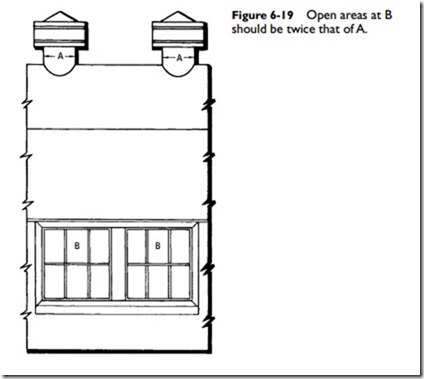Design and Placement of Inlet Air Openings
The purpose of a roof ventilator is to let air escape from the top of a building. This naturally means that a like amount of air must be admitted to the building to take the place of that exhausted. The nature, size, and location of these inlet openings are of importance in determining the effectiveness of the ventilating system.
Inlet air openings are frequently constructed in the form of louvered openings located near the floor line, but they also often consist of the building windows. In general, there are three factors that should be considered when planning for an effective ventilating system:
1. The relationship between the area of the air intakes and the airshaft areas.
2. The distribution of inlet air openings.
3. The height at which air inlets are placed.
The area of the air intakes should at all times be twice that of the combined airshaft area of all ventilators (see Figure 6-19). By keeping
this relationship, the full capacity of the ventilators will be realized, and the velocity of the incoming air will be low, thereby lessening the danger from drafts in the building. Any backdraft down the ventilator itself will also be eliminated.
These inlet air openings should also be distributed in such a way as to allow the admission of fresh air to all parts of the building. They should be located as close to the floor as possible in order to bring the incoming fresh air into the breathing zone.
